

Grand Grimoire. The Grand Grimoire's is a number of grimoire (4 known, the least dark is the Key of Solomon) black magic[1] grimoire one believed to date to 1522.
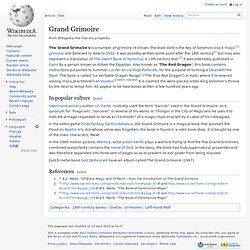
It was possibly written some point after the 18th century[2] but may also represent a translation of The Sworn Book of Honorius, a 13th-century text.[3] It was ostensibly published in Cairo by a person known as Alibek the Egyptian. Also known as "The Red Dragon", this book contains instructions purported to summon Lucifer or Lucifuge Rofocale, for the purpose of forming a Deal with the Devil. The book is called "Le Veritable Dragon Rouge" ("The True Red Dragon") in Haiti, where it is revered among many practitioners of Voodoo. [citation needed] It is claimed the were placed under King Solomon's throne by the devil to tempt him. All appear to be fake books written a few hundred years ago. Magic circle. Boline. Athame. An athame, used in Wiccan ritual practices.
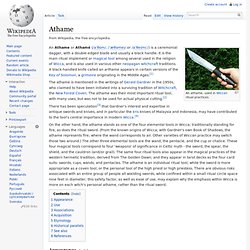
An Athame or Athamé (/əˈθɒm/, /ˈæθəmeɪ/ or /əˈθeɪmiː/) is a ceremonial dagger, with a double-edged blade and usually a black handle. Horned God. The term Horned God itself predates Wicca, and is an early 20th-century syncretic term for a horned or antlered anthropomorphic god with pseudohistorical origins[4] who, according to Margaret Murray's 1921 The Witch-Cult in Western Europe, was the deity worshipped by a pan-European witchcraft-based cult, and was demonized into the form of the Devil by the Mediaeval Church.
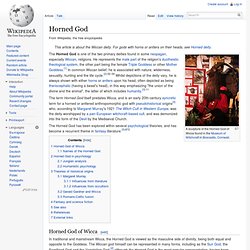
The Horned God has been explored within several psychological theories, and has become a recurrent theme in fantasy literature.[5]:872. Familiar spirit. A late 16th-century illustration of a witch feeding her familiars from England.

When they served witches, they were often thought to be malevolent, while when working for cunning-folk they were often thought of as benevolent (although there was some ambiguity in both cases). Raymond Buckland. Raymond Buckland (born 31 August 1934), whose craft name is Robat, is an English American writer on the subject of Wicca and the occult, and a significant figure in the history of Wicca, of which he is a High Priest in both the Gardnerian and Seax traditions.

According to his written works, primarily Witchcraft from the Inside, published in 1971, he was the first person in the United States to openly admit to being a practitioner of Wicca,[citation needed] and he introduced the lineage of Gardnerian Wicca to the United States in 1964, after having been initiated by Monique Wilson in Britain the previous year. He later formed his own tradition dubbed Seax-Wica which focuses on the symbolism of Anglo-Saxon paganism.[1] Biography[edit] Britain: 1934-1962[edit] When World War II broke out in 1939, the family moved to Nottingham, where Buckland attended Nottingham High School. He went on to be educated at King's College School. USA: 1962-[edit] Triple Goddess (Neopaganism) The Triple Goddess is the subject of much of the writing of Robert Graves, and has been adopted by many neopagans as one of their primary deities.
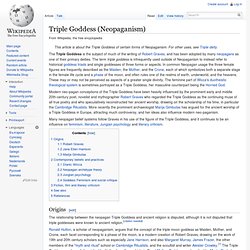
The term triple goddess is infrequently used outside of Neopaganism to instead refer to historical goddess triads and single goddesses of three forms or aspects. Witch's ladder. The Wellington Witch Ladder[edit] Illustration in Colles article.
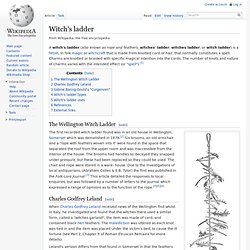
The first recorded witch ladder found was in an old house in Wellington, Somerset which was demolished in 1878.[2] Six brooms, an old armchair and a ‘rope with feathers woven into it’ were found in the space that separated the roof from the upper room and was inaccessible from the interior of the house. The brooms had handles so decayed they snapped under pressure, but these had been replaced so they could be used. The chair and rope were stored in a ware- house. Due to the investigations of local antiquarians, (Abraham Colles & E.B.
Paganism. Paganism is a broad group of indigenous and historical polytheistic religious traditions—primarily those of cultures known to the classical world.
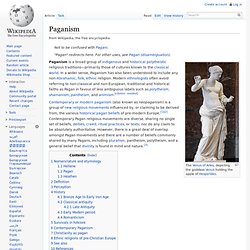
In a wider sense, Paganism has also been understood to include any non-Abrahamic, folk, ethnic religion. Modern ethnologists often avoid referring to non-classical and non-European, traditional and historical faiths as Pagan in favour of less ambiguous labels such as polytheism, shamanism, pantheism, and animism. Celtic Wicca. Celtic Wicca is a modern tradition of Wicca that incorporates some elements of Celtic mythology.[1][2][3] It employs the same basic theology, rituals and beliefs as most other forms of Wicca.[1][2] Celtic Wiccans use the names of Celtic deities, mythological figures, and seasonal festivals within a Wiccan ritual structure and belief system,[1][4] rather than a historically Celtic one.[3][5] Origins[edit] Several different variations of the tradition have existed.
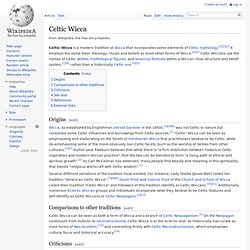
For instance, Lady Sheba (Jessie Bell) called her tradition "American Celtic Wicca".[7][8][9] Gavin Frost and Yvonne Frost of the Church and School of Wicca called their tradition "Celtic Wicca" and followers of this tradition identify as Celtic Wiccans.[10][11] Additionally, numerous Eclectic Wiccan groups and individuals incorporate what they believe to be Celtic features and self-identify as Celtic Wiccans or Celtic Neopagans.[2][12] Comparisons to other traditions[edit] Pentacle. The words pentacle and pentagram (a five-point unicursal star) are essentially synonymous, according to the Online Oxford English Dictionary (2007 revision), which traces the etymology through both French and Italian back to Latin, but notes that in Middle French the word "pentacle" was used to refer to any talisman.
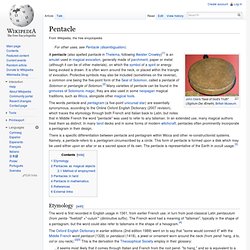
In an extended use, many magical authors treat them as distinct. Icelandic magical staves. Icelandic magical staves (sigils) are symbols called Galdrastafur in Icelandic, and are credited with magical effect preserved in various grimoires dating from the 17th century and later.[1] According to the Museum of Icelandic Sorcery and Witchcraft, the effects credited to most of the staves were very relevant to the average Icelanders of the time, who were mostly subsistence farmers and had to deal with harsh climatic conditions.[1] Pentagram. A pentagram inscribed in a circle, also known as a pentacle A pentagram (sometimes known as a pentalpha or pentangle or a star pentagon) is the shape of a five-pointed star drawn with five straight strokes. The word pentagram comes from the Greek word πεντάγραμμον (pentagrammon),[1] from πέντε (pente), "five" + γραμμή (grammē), "line".[2] The word "pentacle" is sometimes used synonymously with "pentagram"[3] The word pentalpha is a learned modern (17th-century) revival of a post-classical Greek name of the shape.[4] Cultural significance[edit] Early history[edit] In early (Ur I) monumental Sumerian script, a pentagram glyph served as a logogram for the word ub, meaning "corner, angle, nook; a small room, cavity, hole; pitfall" (this later gave rise to the cuneiform sign UB 𒌒, composed of five wedges, further reduced to four in Assyrian cuneiform ).
Magic circle.